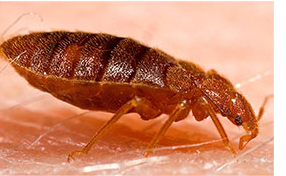Bed Bugs
Bed bugs (Cimex lectularius) are small, oval shaped, wingless insects, about the size of apple seeds. They typically feed on a diet consisting solely of blood once a week, but can live for months without feeding. They usually come out at night to feed on the blood of people and animals, biting their victims as they sleep.
 Bed bugs are not known to spread diseases and the bites do not usually require any medical treatment. Some people, however, can have an allergic reaction to the bite and develop itchy welts. Scratching the bites can lead to infection.
Bed bugs are not known to spread diseases and the bites do not usually require any medical treatment. Some people, however, can have an allergic reaction to the bite and develop itchy welts. Scratching the bites can lead to infection.
After decades of being largely wiped out in Western countries, the bed bug made a comeback in the 1990s. Since then bed bug infestations have been on the rise across Ontario, usually in or around places where people sleep. The flattened bodies of bed bugs allow them to hide in very small places such as mattress seams, cracks, electrical outlets, box springs, headboards, behind wallpaper. Bed bugs can’t climb metal or polished surfaces and aren’t able to fly or jump. They are known to travel, hitching rides on luggage, purses, clothing and books, and showing up in non-residential environments and workplaces such as offices, waiting rooms, retail stores, theatres and even libraries.
Risk of exposure and prevention
Bed bugs can be unknowingly brought into the workplace by workers, visitors, or clients. People who work in or visit locations with bed bug infestations – especially workers who handle fabrics or furniture where bed bugs could be hiding – are at higher risk for exposure. These occupations include midwives and other health-care professionals. Once bed bugs have been picked up, infestation could spread to the midwife’s clinic, vehicle or home, as well as to equipment and personal belongings.
Because of the stigma attached to bed bugs, some clients may not divulge an infestation. To
determine which clients’ homes might be infested, midwives can ask all clients about whether they have any insect problems in their home or if they have noticed any sores or bites on their skin.
Bed bugs have to hitch a ride to travel. Therefore, to the extent possible, take these precautions while at a potentially infected client’s home to reduce the risk of picking up bed bugs:
- Hang personal items such as bags and coats from a door knob or hook to keep them off of the floor.
- Minimize the items taken into a potentially infested environment - take only what is needed.
- Protect all belongings that taken into an infested environment by putting them into sealable plastic containers or bags and placing them in the middle of the room. Be especially careful with fabrics, such as the birth bag itself or heating pad covers.
- During home visits, avoid contact with bedding material or furnishings in sleeping areas unless required, and don’t sit on furniture with fabric or lean on walls.
- Cover up clothing by wearing personal protective equipment (PPE) such as shoe covers.
- Consider changing into work clothes and shoes and removing them before going home or to another area. Keep clothing items in sealed plastic containers or sealed plastic bags to avoid bed bug contact.
- Inspect shoe treads, clothing, cuffs, pockets, collar and belongings after leaving a potentially infested area for small black (fecal matter) or dark red (blood) stains, along with both live and dead bed bugs.
After leaving a location potentially infested with bed bugs or after finding a bed bug:
- Inspect shoes, clothing, equipment and other belongings and those of coworkers after leaving. Shake clothing and shoes before entering any vehicle.
- Keep a spare set of clothes in a sealed container to change into.
- If there are any concerns of having picked up a bed bug, remove clothing (on hard-floored surface) and seal in plastic bag.
- If a bed bug is found, kill it.
- Kill the bed bugs with heat by washing clothes at the hottest recommended setting. Tumble dry clothes on high heat for 30 minutes. Clothes that require dry cleaning should be kept in a sealed plastic bag until dry cleaning.
